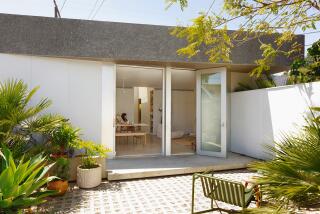Barry Berkus dies at 77; architect of mass-market housing
Barry Alan Berkus, a California architect who left a deep imprint on mass-market housing, spurring trends toward homes with grand entrances, high ceilings, master suites, natural light and open spaces, has died. He was 77.
Berkus, who had leukemia, died Nov. 30 in Santa Barbara, where he had lived for more than 30 years, said his architect son, Jeffrey.
During a career that spanned nearly six decades, the senior Berkus built a portfolio of 600,000 dwellings encompassing about 10,000 designs in developments across the United States, including Playa Vista in Los Angeles, Harbor View in Newport Beach, Turtle Rock Highlands and Woodbridge Landing in Irvine, and Park Imperial South in Palm Springs.
Although not a household name like Frank Gehry or Robert Venturi, Berkus “was a brand name,” said S. Claire Conroy, editor in chief of Residential Architect magazine. “I have heard people say, ‘I live in a Barry Berkus house.’ How many people in developments know the name of the architect who built their house? That is pretty amazing.”
Berkus made his name in an unglamorous field. Instead of focusing on high-profile commercial projects or luxurious custom homes, he decided to concentrate on “design for the 99%,” Conroy said.
At Playa Vista, he designed both high-end and affordable housing. For the latter he conceived 17 homes arrayed in a boomerang shape on an acre of land, a plan that allowed good views as well as high density.
“Barry thought, ‘How are people going to use this space?’” said Playa Vista co-President Randy Johnson. “He was extremely creative. He didn’t want ordinary design. He wanted something that made a difference.”
Conroy wrote in a 2000 profile that Berkus’ designs were “not for the faint of heart,” featuring muscular lines and experiments with materials. She noted that in the late 1960s, when he drew the plans for Harbor View in Newport Beach, he was one of the first architects to incorporate a “bonus” room that could function as an office, spare bedroom or playroom. He also was fascinated with modular housing.
Berkus was born in Los Angeles on Nov. 25, 1935, and grew up in Pasadena, where his father ran a furniture store. After graduating from John Muir High School, he briefly studied economics at UC Santa Barbara. But a lifelong love of drawing led him to transfer to USC’s school of architecture, where he decided to specialize in residential design.
In the 1950s and ‘60s, being a “production architect” for the home-buying masses was one of the least glamorous specialties. “I could lead a design panel at the National Assn. of Home Builders,” Berkus said, “but couldn’t do one at the American Institute of Architects.”
While at USC, Berkus worked part time for L.C. Major, a prominent California housing designer. Major offered him a full-time job but Berkus turned it down, left USC and opened his own architecture office. He was 21.
One of his first big clients was William Levitt, the real estate developer often called the father of American suburbia. Designing Levittowns of identical box houses was not Berkus’ bent, however. He wanted to play with volume, light and shape and give people houses that were “more than just a box.”
“Over time,” he told the Wall Street Journal in 2008, “production architects began to promote the idea that people could live in exciting spaces even if they couldn’t afford their own architect.”
Berkus and his firms, Berkus Design Studio and B3 Architects, won numerous awards over the years. In 1991 he was named one of the world’s 100 top architects by Architectural Digest.
His international work includes master planning of residential villages for Euro Disney in France. Among his other projects were the Santa Barbara Maritime Museum, the Mosher Alumni House at UC Santa Barbara, custom homes for such celebrities as Kenny Loggins and author Richard Bach and a temporary village for athletes competing at Lake Casitas in Ventura County during the 1984 Olympics, when he was commissioner of rowing.
A passionate person, Berkus believed “his next idea was always his greatest idea,” his son said. He rarely went anywhere without his bag of drawing pens and often showed up for business meetings and speaking engagements in his favorite pair of bright red sneakers. He was a bicycling enthusiast and competed in hydroplaning and open water racing.
In 1994, after a financial setback that caused him to drastically scale back his business, he decided he needed an arduous challenge: He climbed to the top of Mt. Vaughan, a 10,302-foot mountain in Antarctica, with the peak’s namesake, Norman Vaughan, who had been a dog-sled driver for Adm. Richard E. Byrd. Berkus subsequently earned membership in the exclusive Explorers Club in New York.
In 1957 he married his high school sweetheart, Gail Hanks; she died in 2000. He is survived by his second wife, Jo Cahow, whom he married in 2005; daughter Carey Berkus; sons Jeffrey and Steven; a brother, David; and four grandchildren.
More to Read
Start your day right
Sign up for Essential California for the L.A. Times biggest news, features and recommendations in your inbox six days a week.
You may occasionally receive promotional content from the Los Angeles Times.







